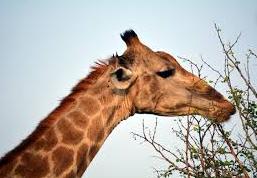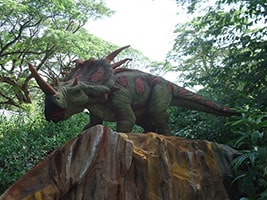 The term " razonear" is used to refer to the action of cutting the ends of the branches of a tree . The term also refers to what certain animals do when they gnaw or eat these tips .
The term " razonear" is used to refer to the action of cutting the ends of the branches of a tree . The term also refers to what certain animals do when they gnaw or eat these tips .
Several species of ruminants are dedicated to browsing for food. These include members of the giraffe group: okapis and giraffes . These beings, which live in the savannahs and forests of the African continent, browse trees and bushes.
In the case of okapis , they can browse on more than a hundred plants. They also eat certain mushrooms, soft shoots and fruits that grow at a certain height (this aspect differentiates browsing from grazing , the action of eating grass directly from the ground). Giraffes , meanwhile, browse the branches of acacias and other trees from which they obtain the proteins they need to grow and stay healthy .
Deer and stags are other animals that rely on browsing for nutrients. Wildebeests do the same.
It is important to know that it is not only in today's fauna that we find specimens suitable for browsing. Many extinct creatures browsed trees and bushes to obtain sustenance, as paleontologists have been able to determine from the study of their remains.
According to research, for example, the Triceratops was a browsing dinosaur. Experts came to this conclusion based on the position of its skull and the end of its jaws, characteristics that reveal the ability of this creature that lived in the Cretaceous period to tear and browse plants. If the Triceratops had had other features, such as teeth more conducive to biting, it would not have browsed as a feeding mechanism.
 From these physical characteristics , which tell us about the feeding habits of each species, we can also better understand which ones would really correspond to our own. For example, no aspect of our body tells us that we should eat meat, since we do not have the essential traits of a hunter: speed and strength superior to those of potential prey, claws and teeth capable of tearing their skin, innate ability to organize into groups to hunt animals larger or stronger than themselves. In other words, browsing seems much more suited to our physiology than killing another mammal with our own hands.
From these physical characteristics , which tell us about the feeding habits of each species, we can also better understand which ones would really correspond to our own. For example, no aspect of our body tells us that we should eat meat, since we do not have the essential traits of a hunter: speed and strength superior to those of potential prey, claws and teeth capable of tearing their skin, innate ability to organize into groups to hunt animals larger or stronger than themselves. In other words, browsing seems much more suited to our physiology than killing another mammal with our own hands.
Other variables that we usually associate with hunting also come into play here: size and appearance . Although not all dinosaurs were “giants,” many of them exceeded the dimensions of the largest animals of today. The Triceratops, to continue with this species, could reach 9 meters in length and 3 meters in height, and weigh up to 12 tons. It is estimated that its head alone could reach 2 meters in length, almost a third of its entire body. Certainly, with these characteristics we could fear that it was a large “monster,” although in reality it was a calm, herbivorous species that did not shed other people’s blood.
The action of browsing is associated with herbivorous animals, those that focus their diet on the consumption of plants. However, in this case it is necessary to refine the definition a little more, since browsing is typical of folivores , a term that in zoology is also known by the name of phyllophages : those species that feed mainly on leaves .
Since a mature leaf contains a high content of cellulose, a biopolymer that is difficult to digest , and a low content of energy, in addition to toxic compounds, the digestive system of a folivorous animal differs from that of a carnivore in two fundamental aspects: it is more extensive and its metabolism is slower.
